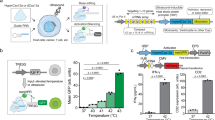Abstract
H19 is expressed in a large percentage of bladder tumors, but not expressed in healthy bladder tissue. The aim of this study is to define H19 optimal transcriptional regulatory sequences in tumor cells, which can potentially be used to control expression of a toxin gene in constructs to be used in bladder cancer gene therapy trials in mice and human. Transient expression assays revealed that elements responsible for promoter activity are contained within the 85 bp upstream region. The transcriptional activity of this region was strongly inhibited by the methylation of the Hpa II sites. A modest cell specificity is conferred by the upstream sequences. The human and murine promoter activities were significantly increased by the human H19 4.1 kb enhancer sequence. The 85 bp H19 upstream region contains all the elements to interact with the enhancer. We showed that the human H19 promoter is highly active in a murine bladder carcinoma cell line, justifying its use to drive the expression of a cytotoxin gene in gene therapy trials in mice.
Similar content being viewed by others
References
Brannan CI, Dees EC, Ingram RS & Tighlman SM (1990) Mol. Cell. Biol. 10: 28–36
Hao Y, Crenshaw T, Moulton T, Newcomb E & Tycko B (1993) Nature 365: 764–767
Dugimont T, Montpellier C, Adriaenssens E, Lottin S, Dumont L, Iotsova V, Lagrou C, Stehelin D, Coll J & Curgy JJ (1998) Oncogene 16: 2395–2401
Lustig-Yariv O, Schulze E, Komitowski D, Erdmann V, Schneider T, de Groot N & Hochberg A (1997) Oncogene 15: 169–177
Li YM, Franklin G, Cui HM, Svensson K, He XB, Adam G & Ohlsson Pfeifer RSJ (1998) Biol. Chem. 273: 2847–28252
Cooper M, Fisher M, Komitowski D, Shevelev A, Schulze E, Ariel I, Tykocinski, M, Miron S, Ilan J, de Groot N & Hochberg A (1996) J. Urol. 155: 2110–2133
Ariel I, Ayesh S, Perlman E, Pizov G, Tanos V, Scheider T, Erdmann V, Podeh D, Komitowski D, Quasem AS, de Groot N & Hochberg A (1997) Clin. Mol. Pathol. 50: 34–44
Ariel I, Miao H, Ji XR, Schneider T, de Groot N, Hochberg A & Ayesh S (1998) J. Clin. Pathol. Mol. Pathol. 51: 21–25
Ariel I, Lustig O, Schneider T, Sappir M, de-Groot N & Hochberg A (1995) Urology 45: 335–338
Pachnis V, Belayew A & Tilghman SM (1984) Proc. Natl. Acad. Sci. USA 81: 5523–5527
Yoo-Warren H, Pachnis V, Ingram RS & Tilghman SM (1988) Mol. Cell.Biol. 8: 4707–4715
Kopf E, Bibi O, Ayesh S, Tykocinski M, Vitner K, de Groot N & Hochberg A (1998) FEBS Lett. 432: 123–127
Ohana P, Kopf E, Bibi O, Ayesh S, Schneider T, Laster M, Tykocinski M, de Groot N & Hochberg A (1999) FEBS Lett. 454: 81–84
Li E, Beard C & Jaenisch R (1993) Nature 366: 362–365
Surani MA (1993) Nature 366: 302–303
Zhang Y, Shields T, Crenshaw T, Hao Y, Moulton T & Tycko B (1993) Am. J. Hum. Genet. 53(1): 113–124
Elkin M, Ayesh S, Schneider T, de Groot N, Hochberg A & Ariel I (1998) Carcinogenesis 19: 2095–2099
Szabo PE, Pfeifer GP & Mann JR (1998) Mol. Cell. Biol. 18 (11): 6767–6776.
Hanson RW (1998) J. Biol. Chem. 273: 28543–28544
Croniger C, Trus M, Lysek-Stupp K, Cohen H., Liu Y, Darlington GJ, Poli V, Hanson RW & Reshef L (1997) J. Biol. Chem. 272: 26306–26312
Lekstrom-Himes J & Xanthopoulos KG (1998) J. Biol. Chem. 273: 28545–28548
Voutilainen R, Ilvesmaki V, Ariel I, Rachmilewitz J, de-Groot N & Hochberg A (1994) Endocrinology 134 (5): 2051–2056
Ben-Haltar J, Beard P & Jirleny J (1989) Nuclei Acids Res. 17 (24): 10179–10189
Baylin SB & Herman JG (2000) TIG 16 (4): 168–174.
Stein R, Razin A & Cedar H (1982) Proc. Natl. Acad. Sci. USA 79: 3418–3422
Vardimon L, Kressmann A, Cedar H, Maechler M & Doerfler, W (1982) Proc. Natl. Acad. Sci USA 79: 1073–1077.
Meehan R, Lewis J, Cross S, Nan X, Jeppesen P & Bird A (1992) J. Cell Sci. Suppl. 16: 9–14.
Author information
Authors and Affiliations
Rights and permissions
About this article
Cite this article
Banet, G., Bibi, O., Matouk, I. et al. Characterization of human and mouse H19 regulatory sequences. Mol Biol Rep 27, 157–165 (2000). https://doi.org/10.1023/A:1007139713781
Issue Date:
DOI: https://doi.org/10.1023/A:1007139713781




